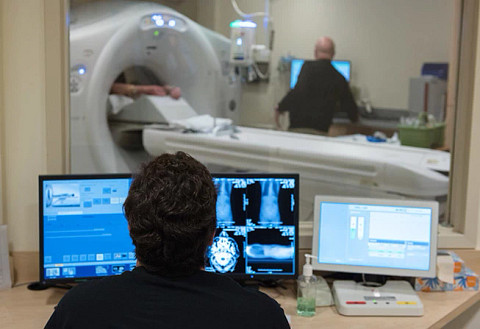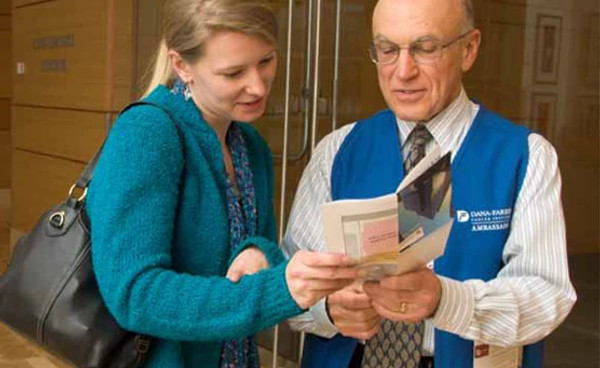
Imaging Services combines the latest techniques for non-invasive imaging studies with compassionate patient care. Our radiologists are board certified and hold academic appointments at Harvard Medical School. Whether you're coming for your first diagnostic scan or are receiving image-guided therapy, the staff in our Imaging Services department is devoted to making your medical imaging experience as comfortable as possible.
The Department of Imaging at Dana-Farber Brigham Cancer Center combines the latest imaging techniques with state-of-the-art scanning equipment and expert staff. Our radiologists, technologists, and nurses are experienced in performing and reading cancer-related imaging studies. They're also compassionate and understanding, because they know how intimidating some of the testing and technology can be.
We aim to make your imaging experience a positive one. We do our best to ensure that you don't feel rushed into or out of our facility, that you feel safe, and that all of your questions and needs are given full attention. We work hard to keep to schedule and minimize your waiting time.
The Department of Imaging is a world-class cancer imaging center of excellence, led by a team of cancer imaging specialists who deliver exceptional cancer imaging expertise for patients, providers, and investigators through our focused services, personalized care, and innovation using state-of-the-art technology.
Dana-Farber-based radiologists use a disease-centric approach, which includes whole-body and multi-modality interpretations that are very valuable to our clinicians. We adhere to the highest safety and quality standards and operate under cost-effective and efficient practices.
Our Approach to Imaging
We are committed to providing personalized, compassionate care. Our receptionists are knowledgeable about our imaging procedures, and our technologists and nurses can answer your questions and guide you through your appointments with care and respect.
Our facilities are designed with comfort and easy accessibility in mind. We have a separate waiting area for gowned patients and a private mammography suite that provides patients with their own dressing rooms and waiting room. If you need anything, please ask our staff.
Most routine imaging can be scheduled within two days; emergency studies can be scheduled the same day.
Our Clinical Services
Our clinical services include:
- CT
- MRI
- Ultrasound
- Digital radiography
- Mammography
- Nuclear medicine, including bone scans and MUGA scans
- PET/CT
- Theranostics (radiopharmaceutical therapy)
- Nurse-to-draw laboratory specimen collection/IV/central line access
- Consultation services
Theranostics (Therapy + Diagnostics = Theranostics)
Theranostics is a combination of therapy with radioactive medicine (called radiopharmaceuticals) and diagnostic imaging. The diagnostic part allows clinicians to determine if a patient's cancer cells have a specific target for treatment. The radiopharmaceutical therapy is then administered if the imaging shows that the target is present. This approach helps the care team to personalize treatment for each patient. It also allows higher doses of radiation to be delivered to tumors, while reducing damage to the surrounding healthy tissues. The diagnostic exam and treatment length vary based on the patient's needs.
Computed Tomography (CT)
Computed Tomography uses low energy X-rays to produce a series of highly detailed, cross-sectional images of your body. A typical CT examination lasts about 20 minutes, during which time several images will be taken.
Magnetic Resonance Imaging (MRI)
Magnetic resonance imaging uses a strong magnetic field and radiofrequency pulses to produce a series of highly detailed, cross-sectional images of your body. A typical MRI examination lasts about 45 minutes, during which time several images will be taken.
Mammography
Mammography uses low energy X-rays to produce images of your breast tissue. These images are used to screen for breast cancer or to evaluate symptoms (e.g., lumps, thickening, etc.) A typical mammogram lasts about 20 minutes, during which time several images may be taken.
Nuclear Medicine and Molecular Imaging (including PET/CT)
Nuclear medicine and molecular imaging use special imaging products (called radiopharmaceuticals*) to take pictures of different processes happening in the body. A typical scan starts with an injection of the radiopharmaceutical into an intravenous (IV) line. Then, specialized cameras are used to take pictures of where the radiopharmaceutical went in the body. The pictures also show how the organs and tissues in the body are functioning. These appointments may last anywhere from 45 minutes to 4 hours, depending on the test.
*Radiopharmaceuticals are compounds or drugs that are attached to small amounts of a radioactive substance. The amount of the compound or drug in a radiopharmaceutical is also very small. Radiopharmaceuticals are used to make images of processes that are happening in the body, but they do not affect how the body works.
Radiography (X-ray)
Radiography is one of the oldest forms of imaging examinations, and is still the most frequently used. This imaging technique uses low energy X-rays to produce an image of your organs and tissues. A typical X-ray examination lasts about 15 minutes per each area of interest, during which time several images may be taken.
Ultrasound (also called sonography or ultrasonography)
Ultrasound is an imaging examination that uses the energy of high-frequency sound waves to produce an image of your organs and tissues. Your tissues will reflect, absorb, and refract the waves differently, and these "echoes" are collected and transformed into an image. A standard ultrasound examination may last up to 60 minutes, during which several images may be taken.
Some of our clinical services are also provided throughout the Dana-Farber network, including satellite sites and community-based services in the Greater Boston area with our Mammography Van and the breast imaging services at Whittier Street Health Center.
Our physics, technical, and medical experts routinely collaborate in a multidisciplinary "Triad" committee to optimize clinical, quality, and safety standards, in addition to developing multimodality approaches and protocols.
Clinical Trials
As part of our ongoing research program, imaging physicians and scientists work together with medical oncologists and investigators to develop and conduct clinical research.
Many patients will have the opportunity to join a clinical trial as one of their treatment options. Imaging staff often participate in clinical research protocols, assisting with the visualization and measurement of disease and determining response to treatment. This research helps identify and establish the best treatments for current and future patients.




